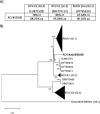Two decades of occurrence of non-pathogenic rabbit lagoviruses in Italy and their genomic characterization
- PMID: 39587141
- PMCID: PMC11589700
- DOI: 10.1038/s41598-024-79670-y
Two decades of occurrence of non-pathogenic rabbit lagoviruses in Italy and their genomic characterization
Erratum in
-
Author Correction: Two decades of occurrence of non-pathogenic rabbit lagoviruses in Italy and their genomic characterization.Sci Rep. 2025 Feb 6;15(1):4517. doi: 10.1038/s41598-025-88648-3. Sci Rep. 2025. PMID: 39915646 Free PMC article. No abstract available.
Abstract
Lagoviruses are viruses of the Caliciviridae family affecting lagomorphs. Both pathogenic and non-pathogenic lagoviruses affect the European rabbit (Oryctolagus cuniculus), and they are phylogenetically distinguished. Rabbit Hemorrhagic Disease Virus (RHDV/GI.1) and Rabbit Hemorrhagic Disease Virus-2 (RHDV-2/GI.2) belong to the first group, while in the second group, several genotypes of Rabbit Calicivirus (RCV/GI.3-GI.4) are present. The first RCV strain was described in Italy in 1996, and since then, several RCV strains have been characterised in Europe and Australia. RCVs, different from the pathogenic hepatotropic RHDVs, have an enteric tropism and could be identified from the duodenum/intestine and faeces. This study aimed firstly to indirectly show through a seroepidemiological survey from 1998 to 2008 the circulation of RCVs strains in rabbit farms and then to genetically characterise RCV strains diagnosed in Italy in faecal and intestinal samples of wild and farmed rabbits collected in various regions in the following years (2000-2022). Of 262 analysed samples, 69 resulted in RT-PCR positive for lagovirus but negative for RHDV. Eleven RCV strains were characterised by complete vp60 sequencing. Phylogenetic analysis showed that the Italian RCV strains are grouped in European (RCV_E1/GI.3) and Australian (RCV_E2/GI.4) RCV clusters, with an estimated country prevalence of 26%. Based on the proposed genotype classification, considering the nucleotide differences of vp60 higher than 15%, we can hypothesise that two other genotypes, GI.5 and GI.6, might exist within the cluster of non-pathogenic viruses.
Keywords: Italy; Lagovirus; Phylogenesis; Rabbit calicivirus; Serology.
© 2024. The Author(s).
Conflict of interest statement
Declarations. Competing interests: The authors declare no competing interests. Ethics declarations: Ethical review and approval were waived for this study that did not involve killing animals. The samples did not originate from experimental trials. Still, they took advantage of diagnostic activity conducted on found dead animals to ascertain the cause of death or as a control of the health status of regularly slaughtered rabbits for human meat consumption. Therefore, since the sampling was not specifically programmed as an experimental study but originating from diagnostic activity, we believed that it does not fall under the provisions of the National Law (e.g. DLSG 4/3 2014, n. 26. Application at the national level of the EU Directive 2010/63/UE) and no ethical approval or permit for animal experimentation was required.
Figures




References
-
- Le Pendu, J. et al. Proposal for a unified classification system and nomenclature of lagoviruses. J. Gen. Virol.98, 1658–1666. 10.1099/jgv.0.000840 (2017). - PubMed
-
- Liu, S. J., Xue, H. P., Pu, B. Q. & Qian, N. H. A new viral disease in rabbits. J. Vet. Diagn. Invest.16, 253–255 (1984).
-
- Morisse, J. P., Le Gall, G. & Boilletot, E. Hepatitis of viral origin in Leporidae: Introduction and aetiological hypotheses. Rev. Sci. Tech.10, 269–310 (1991). - PubMed
-
- Le Gall-Recule, G. et al. Detection of a new variant of rabbit haemorrhagic disease virus in France. Vet. Rec.168, 137–138. 10.1136/vr.d697 (2011). - PubMed
MeSH terms
Grants and funding
LinkOut - more resources
Full Text Sources
Research Materials

